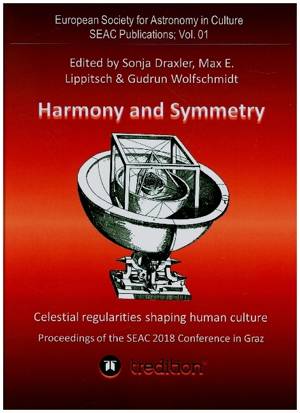
Door een staking bij bpost kan je online bestelling op dit moment iets langer onderweg zijn dan voorzien. Dringend iets nodig? Onze winkels ontvangen jou met open armen!
- Afhalen na 1 uur in een winkel met voorraad
- Gratis thuislevering in België vanaf € 30
- Ruim aanbod met 7 miljoen producten
Door een staking bij bpost kan je online bestelling op dit moment iets langer onderweg zijn dan voorzien. Dringend iets nodig? Onze winkels ontvangen jou met open armen!
- Afhalen na 1 uur in een winkel met voorraad
- Gratis thuislevering in België vanaf € 30
- Ruim aanbod met 7 miljoen producten
Zoeken
Harmony and Symmetry. Celestial regularities shaping human culture.
Proceedings of the SEAC 2018 Conference in Graz. Edited by Sonja Draxler, Max E. Lippitsch & Gudrun Wolfschmidt. SEAC Publications; Vol. 01
Gudrun Wolfschmidt
€ 49,45
+ 98 punten
Uitvoering
Omschrijving
For the SEAC conference in Graz (2018) and for the Proceedings the motto "Harmony and symmetry - celestial regularities shaping human culture" was chosen. There were at least two strong reasons for this motto: First, the connection between astronomy and human culture has an extremely long tradition, and one of its absolute high points is the astronomer Johannes Kepler, who spent his entire life searching for the relationship between the movement of heavenly lights and ideas about harmonious structures and regular bodies. Kepler started his scientific career and authored his first book, the Mysterium cosmographicum, in Graz. Kepler argued in his first publication for the twelve-fold partition of the zodiac with arguments derived from the monochord, anticipating the procedure he developed in his Harmonices mundi. Five contributions deal with Kepler, including the harmony in musical theory. The second reason was the Eggenberg Castle. This palace, built for the nobleman Hans Ulrich von Eggenberg (1568-1634), is a remarkable piece of symmetry and harmony and an outstanding example of a strong connection between astronomy and culture. Seven contributions have the topic astronomy, astrology and architecture with the emphasis on astronomical orientation, symmetry and harmony in the Middle Ages and Renaissance. The Proceedings with ten chapters and 44 contributions range besides the mentioned "Middle Ages and beyond" and Johannes Kepler from Prehistoric Times, Bronze and Iron Age, Mythology and Ethnoastronomy, Babylonian Astronomy, Greek and Roman Astronomy, Meso- and South America, Middle East and Eastern Asia and Computational Astronomy. The celestial sphere, regarded as the sky of astronomy, as well as the heaven of divine numina, from Antiquity to Copernicus and Kepler was equated with symmetry, harmony, and beauty. Until today, this has been reflected in the structure of cultural creations, from architectural objects to musical forms.
Specificaties
Betrokkenen
- Auteur(s):
- Uitgeverij:
Inhoud
- Aantal bladzijden:
- 442
- Taal:
- Engels
- Reeks:
- Reeksnummer:
- nr. 1
Eigenschappen
- Productcode (EAN):
- 9783347146334
- Verschijningsdatum:
- 29/12/2020
- Uitvoering:
- Hardcover
- Formaat:
- Genaaid
- Afmetingen:
- 178 mm x 254 mm
- Gewicht:
- 979 g

Alleen bij Standaard Boekhandel
+ 98 punten op je klantenkaart van Standaard Boekhandel
Beoordelingen
We publiceren alleen reviews die voldoen aan de voorwaarden voor reviews. Bekijk onze voorwaarden voor reviews.











